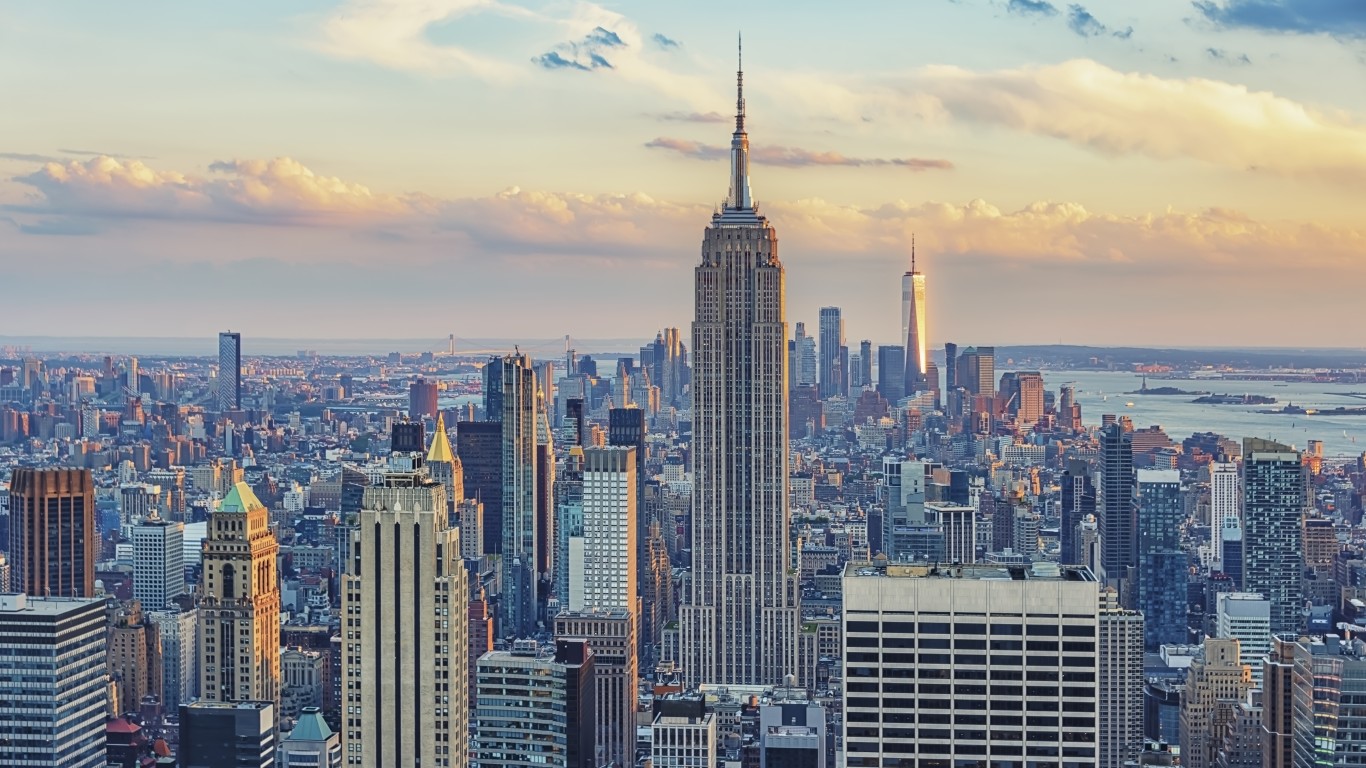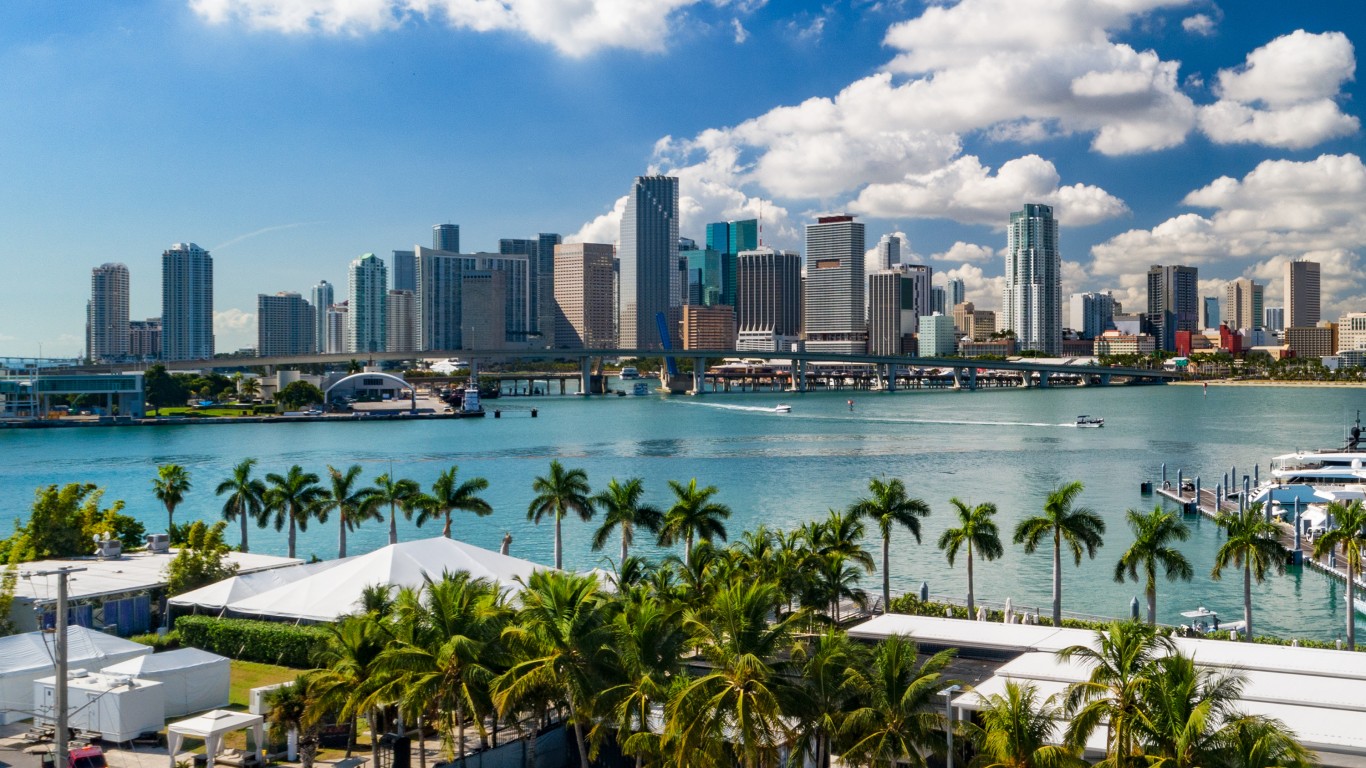
The United States has its fair share of large cities, all of which have cultural associations, pop references, and a deep history that surrounds them. Big cities are where the exciting things happen. Big cities are the melting pots of ideas, creatives, and cultures, and big cities are where, well, lots of people are.
The biggest cities in the United States today, however, may not be the biggest cities in the future. At one point in the past, Philidelphia was larger than New York, but nowadays, The Big Apple is uncontested by the City of Brotherly Love. Today, we’re going to look at the 10 Largest Cities in the United States and then look at what the data says will be the case in 2050.
To compile this list, 24/7 Wall Street used data from Ontario Tech University, titled: Population predictions of the 101 largest cities in the 21st century. Additionally, data gathered from the 2020 Census was used to determine current population numbers in major hubs. Let’s take a look at these cities, plus where they will end up in 2050 (it’s not that far away!).
The 10 Largest Cities in the United States
| Ranking | City | Population 2020 (Most Recent Census) |
| 1 | New York, New York | 8,622,357 |
| 2 | Los Angeles, California | 4,085,014 |
| 3 | Chicago, Illinois | 2,670,406 |
| 4 | Houston, Texas | 2,378,146 |
| 5 | Phoenix, Arizona | 1,743,469 |
| 6 | Philadelphia, Pennsylvania | 1,590,402 |
| 7 | San Antonio, Texas | 1,579,504 |
| 8 | San Diego, California | 1,469,490 |
| 9 | Dallas, Texas | 1,400,337 |
| 10 | San Jose, California | 1,036,242 |
As of right now, the top 10 largest cities in the United States probably aren’t surprising. New York has been sitting at the top of this list for quite some time now, and it doesn’t look to change anytime soon. In fact, New York City became the most populated city in 1790, surpassing Philadelphia (despite it just being named the capital of the country).

Also, it’s important to note that these are the actual city limits of these places, and city limits aren’t always the most accurate way to measure a city’s population. Instead, the “metro area” is often used, encompassing the core city, nearby communities, and related areas. For example, if we were to look at metro areas, the Washington-Arlington-Alexandria metro area would take the number six spot, pushing the Philadelphia-Camden-Wilmington metro area to number seven. Other additions to the list, if going by metro area, would be the Atlanta metro (number eight) and Miami metro (number nine).
The 10 Largest Metro Areas in the United States in 2050

Let’s take a look at some of the projections for the largest cities in the U.S. in 2050. To the (utter) dismay of many, this is a mere 25 years away, so we can expect to see these trends realized in most of our lifetimes.
| City | Metro Population 2022 | Metro Population 2050 |
| New York, New York | 19,768,000 | 24,768,743 |
| Los Angeles, California | 12,872,322 | 16,416,436 |
| Chicago, Illinois | 9,274,140 | 11,925,691 |
| Dallas-Fort Worth, Texas | 7,943,685 | 6,506,778 |
| Houston, Texas | 7,368,466 | 6,062,506 |
| Washington D.C. | 6,265,183 | 5,870,389 |
| Philadelphia, Pennsylvania | 6,241,164 | 7,364,102 |
| Atlanta, Georgia | 6,237,435 | 6,184,981 |
| Miami, Florida | 6,139,340 | 7,531,004 |
| Boston, Massachusetts | 4,900,550 | 6,042,094 |
It is important to note that this time, we are talking about metro areas, not city cores. The data posted from the research paper doesn’t explicitly say this, but it’s the only reasonable interpretation of the data.
A few things are noteworthy here. Let’s look over some of the key findings from the data, plus some potential issues within the original paper.
New York Likely to Stay #1

First, New York has kept its top spot, and it’s not really close. Although 2050 feels like a long way off, it probably isn’t enough time to drastically influence the population of a city of that scale. Still, we have seen recent events drastically alter the population of major cities, notably COVID-19. New York lost hundreds of thousands of people during and after the pandemic and is only just now beginning to change the downward population trend.
Mid-Sized Metros Expected to Grow

Second, using the metro areas instead of the city core drastically changes how things are organized. For reference, Miami shows up as number nine on the list when it wouldn’t conventionally rank as high. This tells us that metro areas may be a better marker for large regional population changes instead of just “downtown” areas. Especially with how American cities are often laid out, with more compact “downtowns” and sprawling suburban regions surrounding them, this could be more accurate.
There Could Be Issues With Data

Thirdly, the data from Ontario Tech shows population drops in many large metro areas. Dallas-Fort Worth, for example, shows a drop of nearly 1.4 million people. This is extremely interesting, primarily because the Dallas-Fort Worth metro has only seen population increases for nearly 100 years. Other population drops include Washington, D.C., and Atlanta.
As far as we can tell, this seems to be the result of strange boundary drawing for some of these regions. This can be seen by looking at the population estimate for Dallas-Fort Worth in 2025 on the paper, which it listed as 5.42 million. Currently, Dallas-Fort Worth is much larger than that (in 2024, no less), so clearly, there is a discrepancy that needs sorting.
2050: Will We Hit These Numbers?

Predicting the population of cities in 2050 involves examining various factors, including average growth rates, demographic shifts, and the impact of significant events on urban landscapes. Cities are kind of like living things; they experience growth, decline, and adaptation to changing environments.
Large cities often exhibit more gradual changes in population due to their sheer size and established infrastructure. As a result, they generally have steady growth with smaller percentage increases. On the other hand, smaller cities may undergo more pronounced percentage changes in population, even with relatively smaller absolute numbers.
In megacities like New York, these incremental changes in population translate into substantial numbers. Even a modest percentage increase or decrease represents a considerable influx or exodus of people.
Uninterrupted, these trends are pretty established and easily modeled. This means that, yes, it’s very likely that these numbers are accurate, especially since they were measured with data originally gathered from the UN.
Unpredictable Events

That being said, there is still the possibility that world events change these trends. If you had asked people 20 years ago about the likelihood of a mass exodus from New York, the odds would have been pretty low. Then, 2020 and COVID happened.
Historically, large events such as pandemics, economic crises, and natural disasters have disrupted population trends. COVID-19, for instance, prompted a notable exodus from some major urban centers as remote work became more prevalent and people went home to wait things out.
Looking towards the future, climate change could be one of the most important factors when considering just how accurate these predictions are. In some models, there is an expected 8-30 inch rise in sea level by the 2050s, drastically impacting New York City’s population (and all other coastal cities).
In 20 Years, I Haven’t Seen A Cash Back Card This Good
Credit card companies are at war, handing out free rewards and benefits to win the best customers. A good cash back card can be worth thousands of dollars a year in free money, not to mention other perks like travel, insurance, and access to fancy lounges. Our top pick today has pays up to 5% cash back, a $200 bonus on top, and $0 annual fee. Click here to apply before they stop offering rewards this generous.
Flywheel Publishing has partnered with CardRatings for our coverage of credit card products. Flywheel Publishing and CardRatings may receive a commission from card issuers.
Thank you for reading! Have some feedback for us?
Contact the 24/7 Wall St. editorial team.



